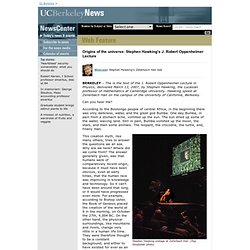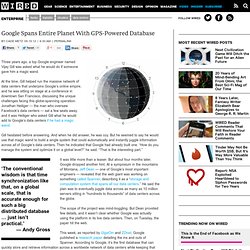

100 Best Apps. Print - 110 Predictions For the Next 110 Years. · People will be fluent in every language.

With DARPA and Google racing to perfect instant translation, it won't be long until your cellphone speaks Swahili on your behalf. · Software will predict traffic jams before they occur. Using archived data, roadside sensors, and GPS, IBM has come up with a modeling program that anticipates bumper-to-bumper congestion a full hour before it begins. Better yet, the idea proved successful in early tests—even on the Jersey Turnpike. · Climate-controlled jackets will protect soldiers from extreme heat and cold. Human Powered Phone Chargers - The Charging Clip Uses Expelled Energy to Charge Your Phone. 92 more must-have tech toys. 03.16.2007 - Origins of the universe: Stephen Hawking's J. Robert Oppenheimer Lecture. UC Berkeley Web Feature Origins of the universe: Stephen Hawking's J.

Robert Oppenheimer Lecture BERKELEY – The is the text of the J. Robert Oppenheimer Lecture in Physics, delivered March 13, 2007, by Stephen Hawking, the Lucasian professor of mathematics at Cambridge University. Hawking spoke at Zellerbach Hall on the campus of the University of California, Berkeley. Can you hear me? According to the Boshongo people of central Africa, in the beginning there was only darkness, water, and the great god Bumba. This creation myth, like many others, tries to answer the questions we all ask. Not everyone however, was happy with the idea that the universe had a beginning. If one believed that the universe had a beginning, the obvious question was, What happened before the beginning? This is still the picture in the mind of many scientists today. In terms of the positivist approach, one can compare two models of the universe.
In an unchanging universe, there would be no natural starting point. Is Soylent The Future Of (Not) Eating? This Guy Reinvented the Wheel ... by Turning It Into a Cube. Seriously.

The SharkWheel in action (Kickstarter) What's better at being a wheel than ... a wheel? That is not a rhetorical question or a Zen kōan or the start to an awesome joke (sorry). Inventor David Patrick, an avid skateboarder, stumbled (or, you know, skated) onto a way to reinvent the wheel as something that he claims is better than the tradition cylindrical model -- something faster, more stable, and more ground-gripping. Its inspiration, Patrick says, "came from a cube. " So what is the SharkWheel, exactly? It comes down to the materials used to modify the wheel. "The helix shape was balanced," Patrick explains, meaning that, whatever terrain the helix traversed, it kept traveling. Patrick turned that insight into a series of skateboard wheels designed for different types -- and terrains -- of skateboarding. Patrick and his team are marketing the wheels as technology for skateboarding. How The Internet REALLY Works. 50 Apps That Can Make You More Productive - SkyDrive.
Science & Nature - Human Body and Mind - Mind - Personality. Google Spans Entire Planet With GPS-Powered Database. Three years ago, a top Google engineer named Vijay Gill was asked what he would do if someone gave him a magic wand.

At the time, Gill helped run the massive network of data centers that underpins Google’s online empire, and he was sitting on stage at a conference in downtown San Francisco, discussing the unique challenges facing this globe-spanning operation. Jonathan Heiliger — the man who oversaw Facebook’s data centers — sat a few seats away, and it was Heiliger who asked Gill what he would add to Google’s data centers if he had a magic wand. Gill hesitated before answering. And when he did answer, he was coy. But he seemed to say he would use that magic wand to build a single system that could automatically and instantly juggle information across all of Google’s data centers. ‘The conventional wisdom is that time synchronization like that, on a global scale, that is accurate enough for such a big distributed database … just isn’t practical.’ — Andy Gross.